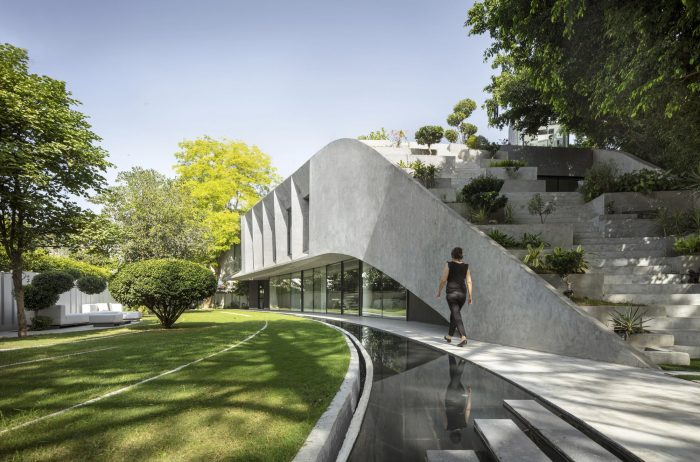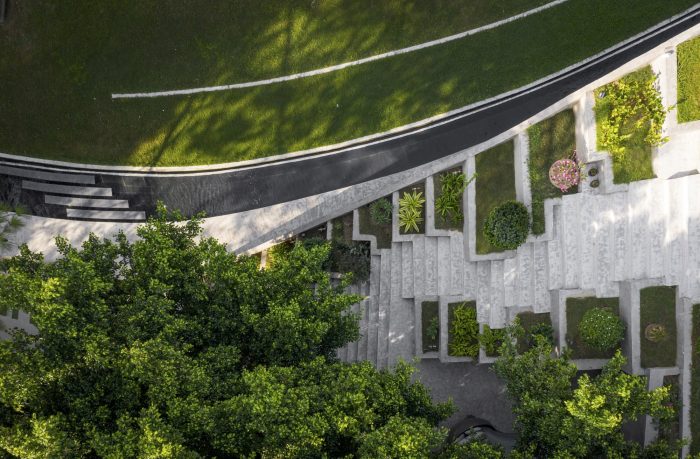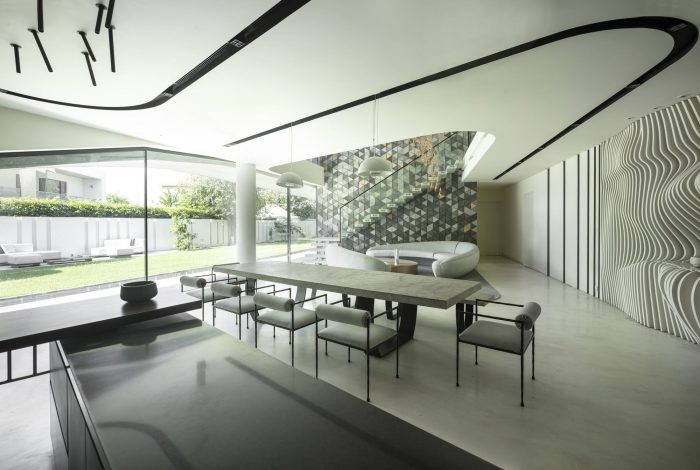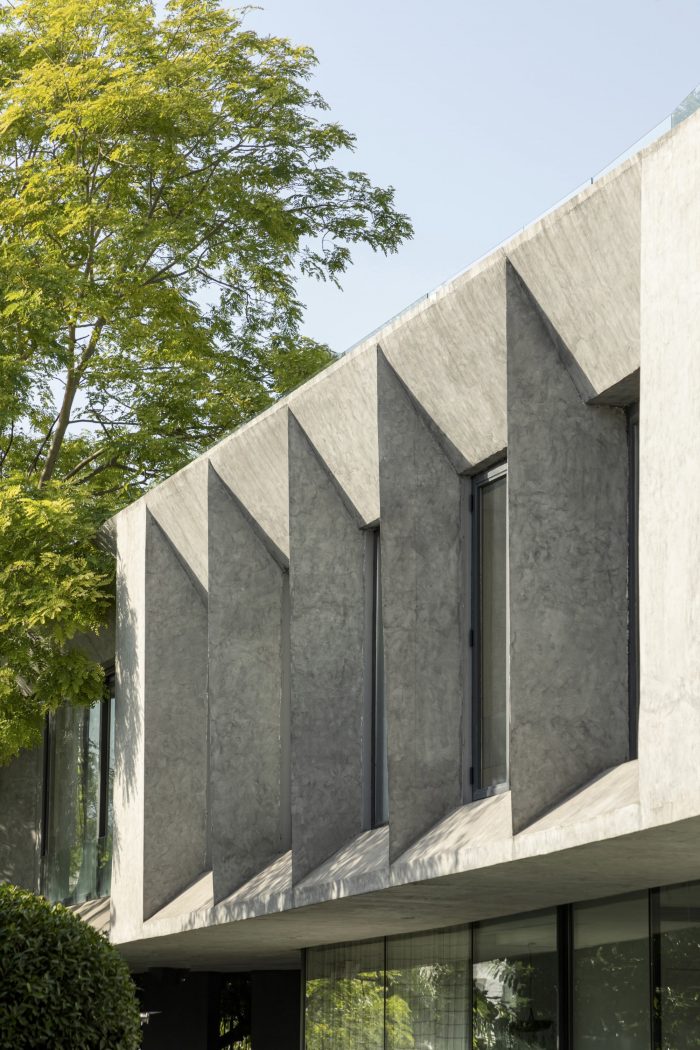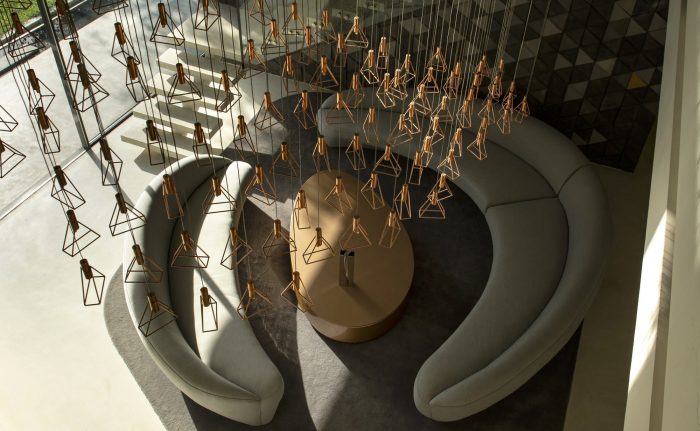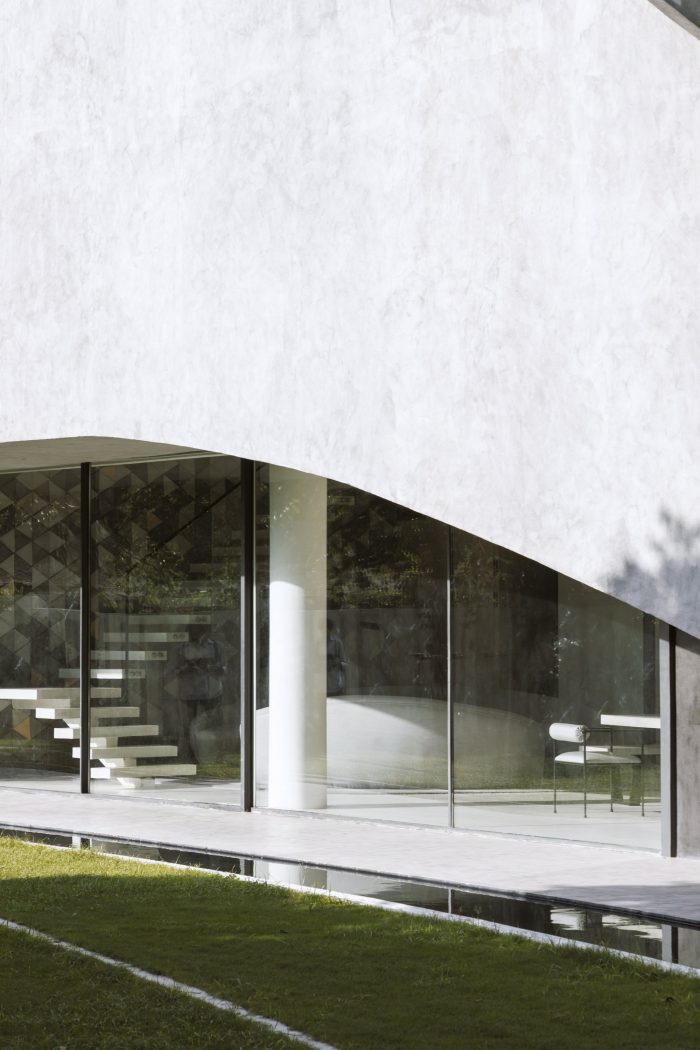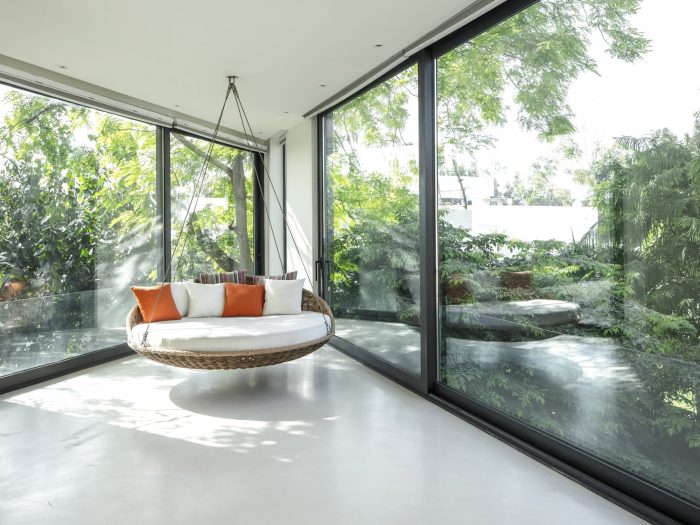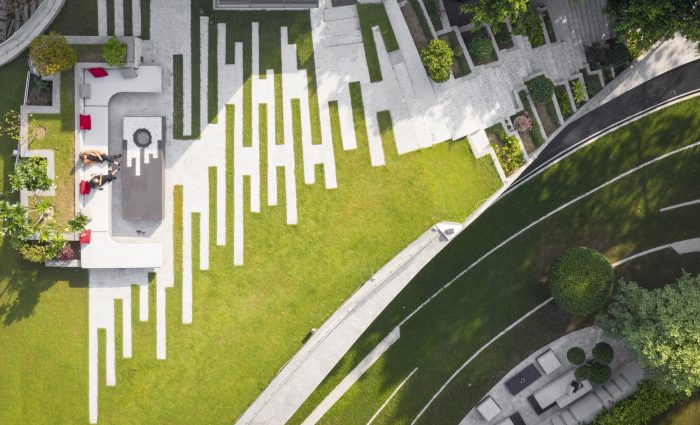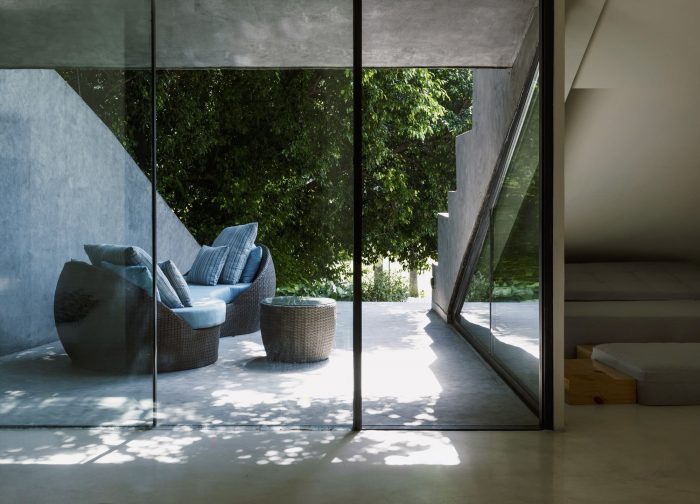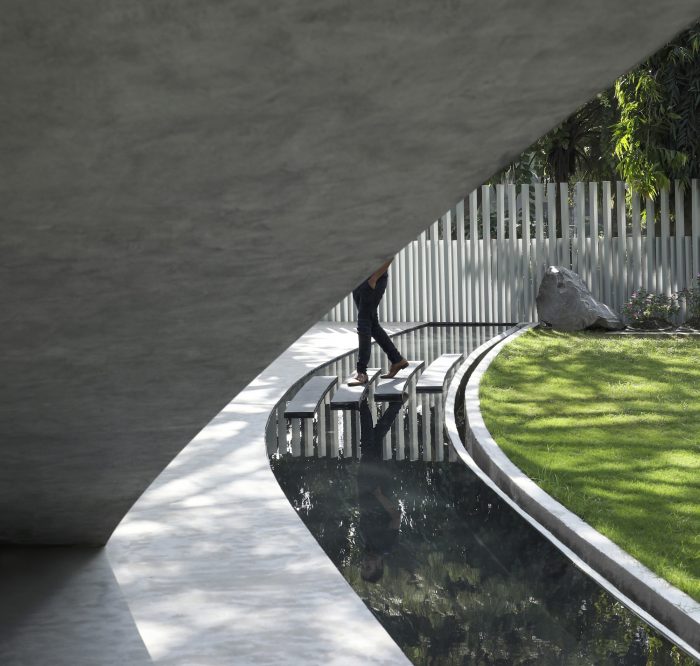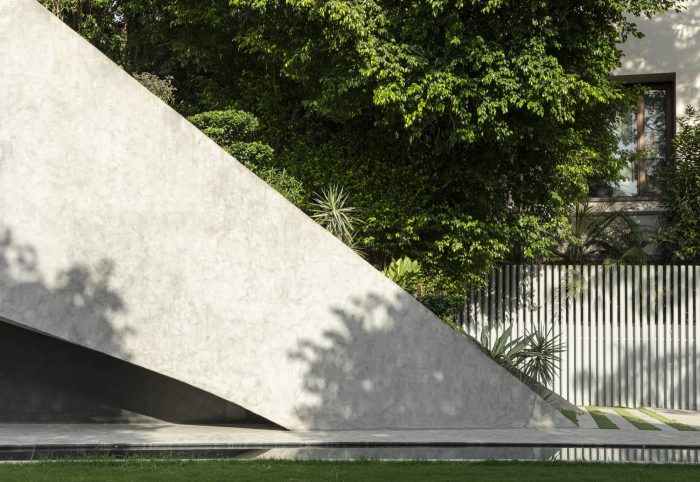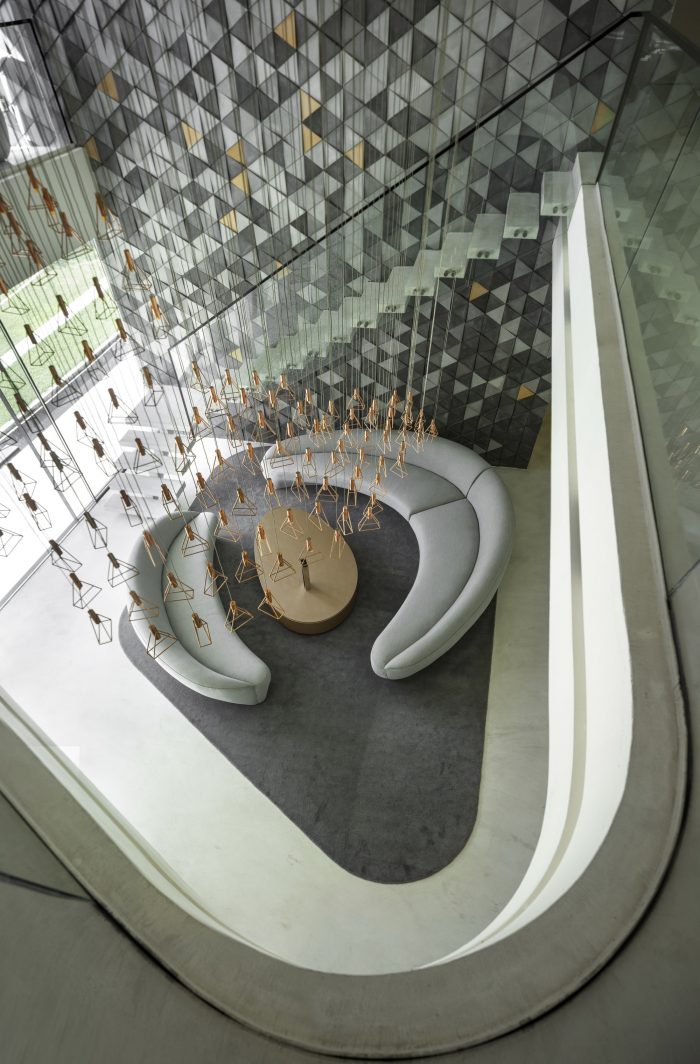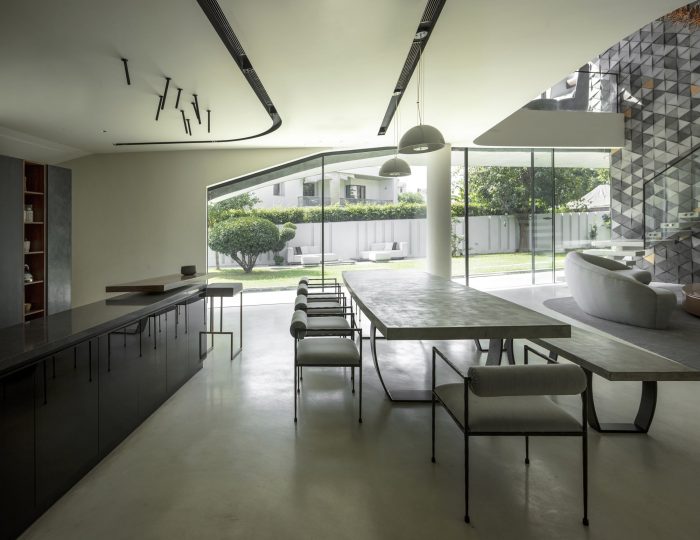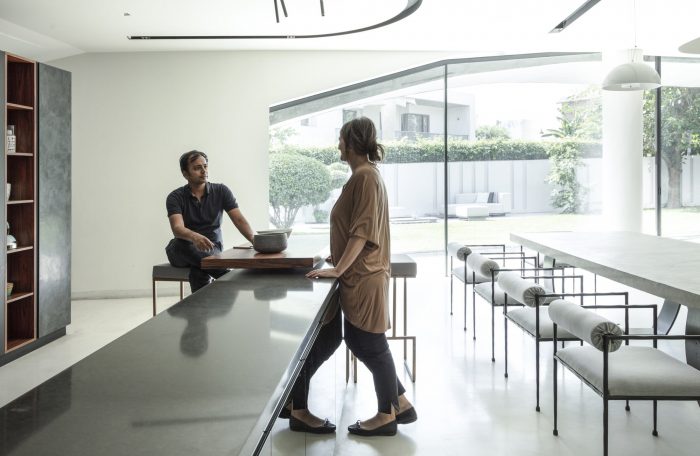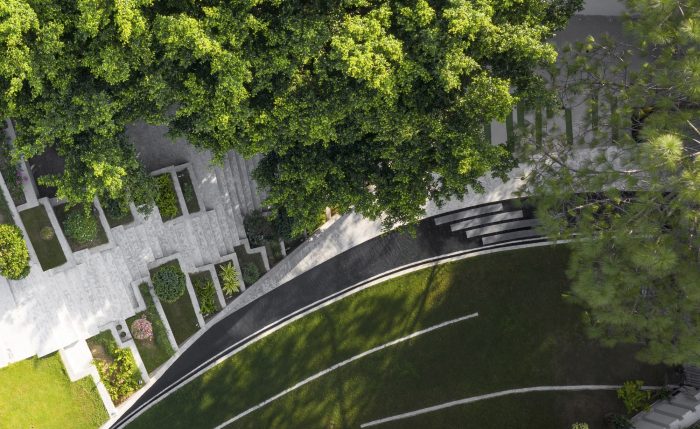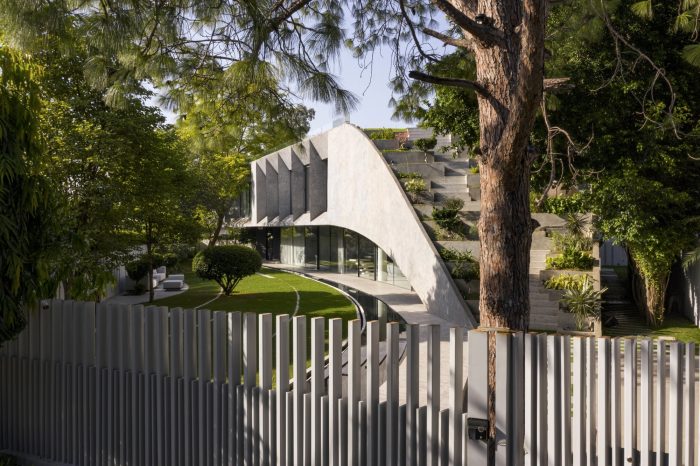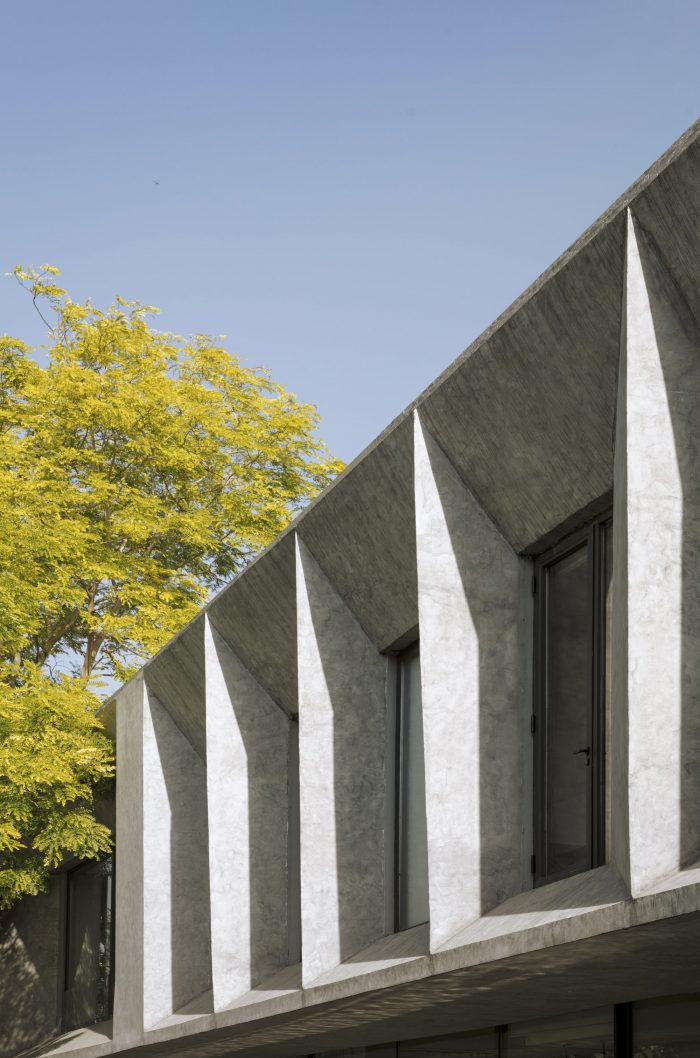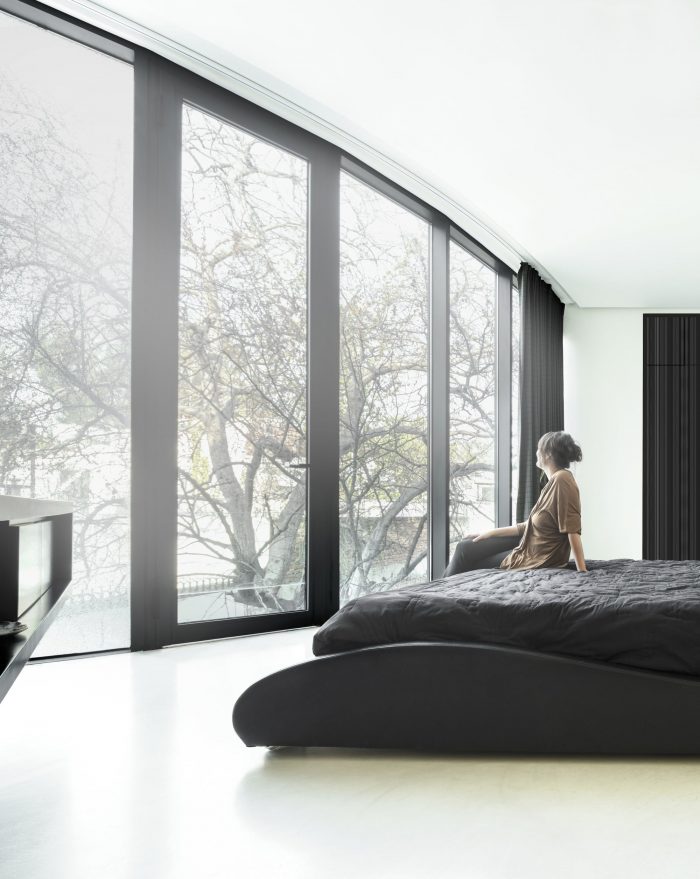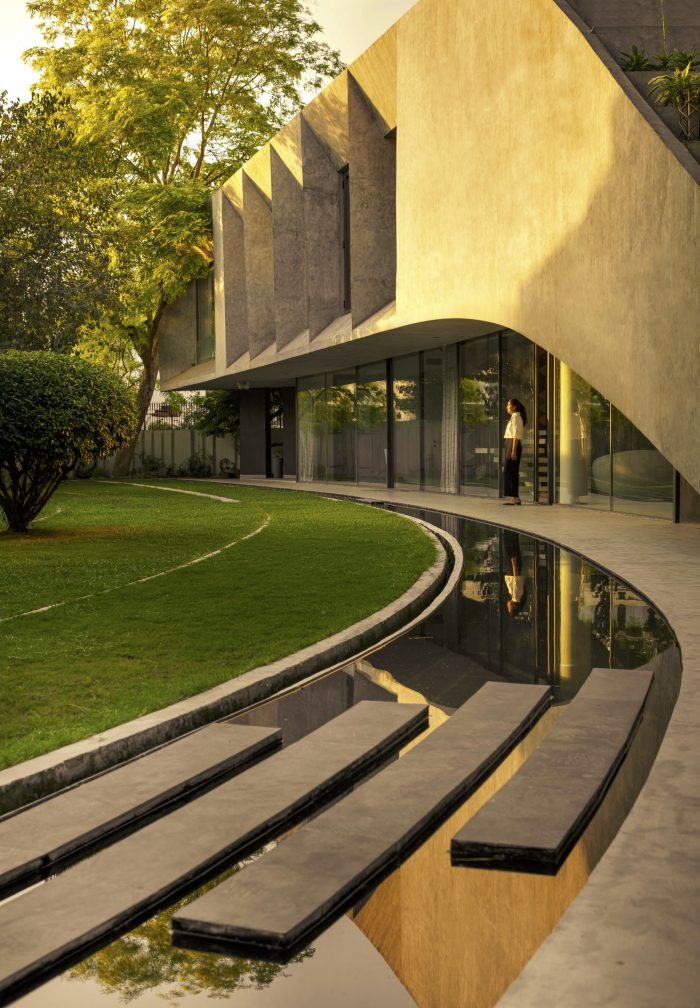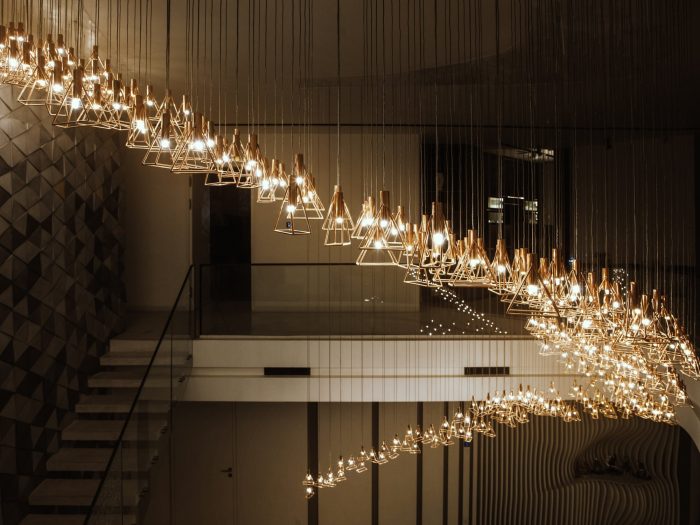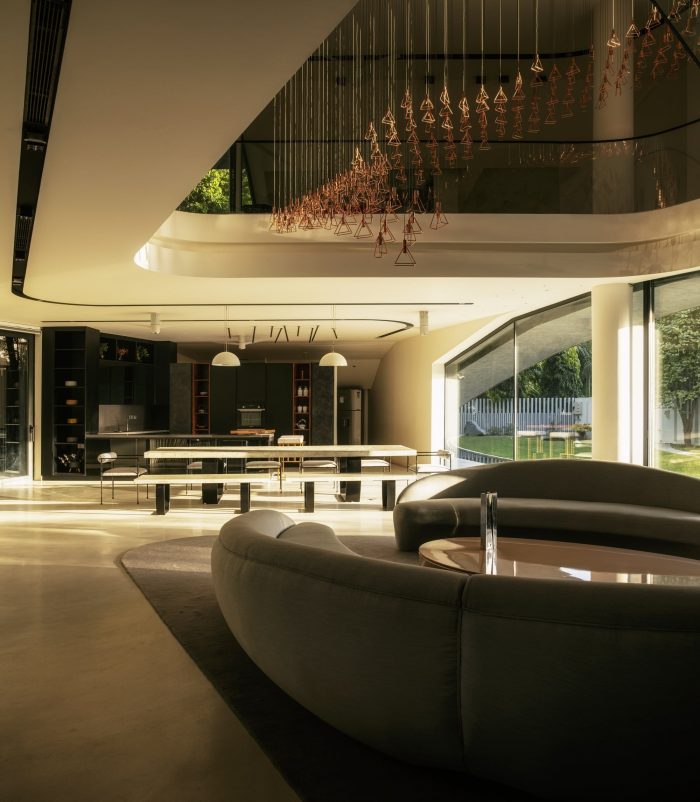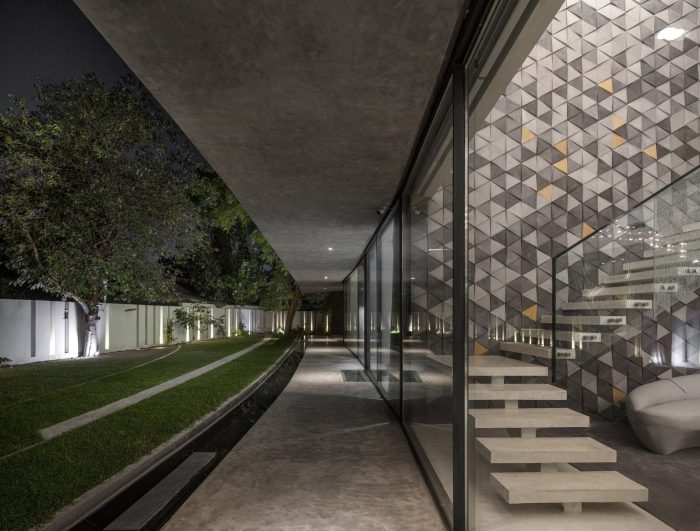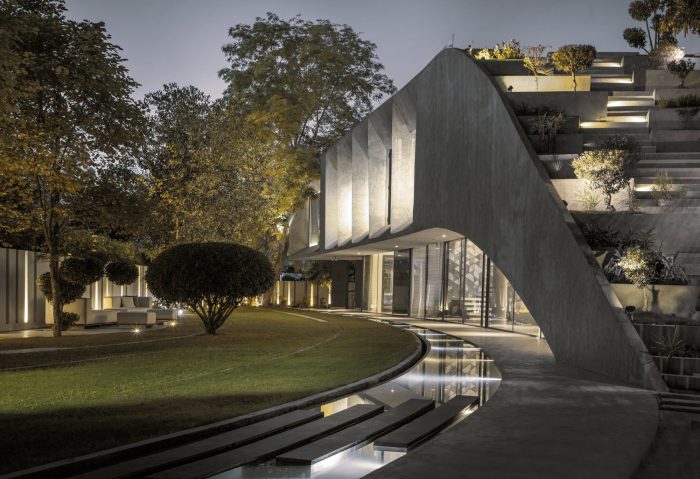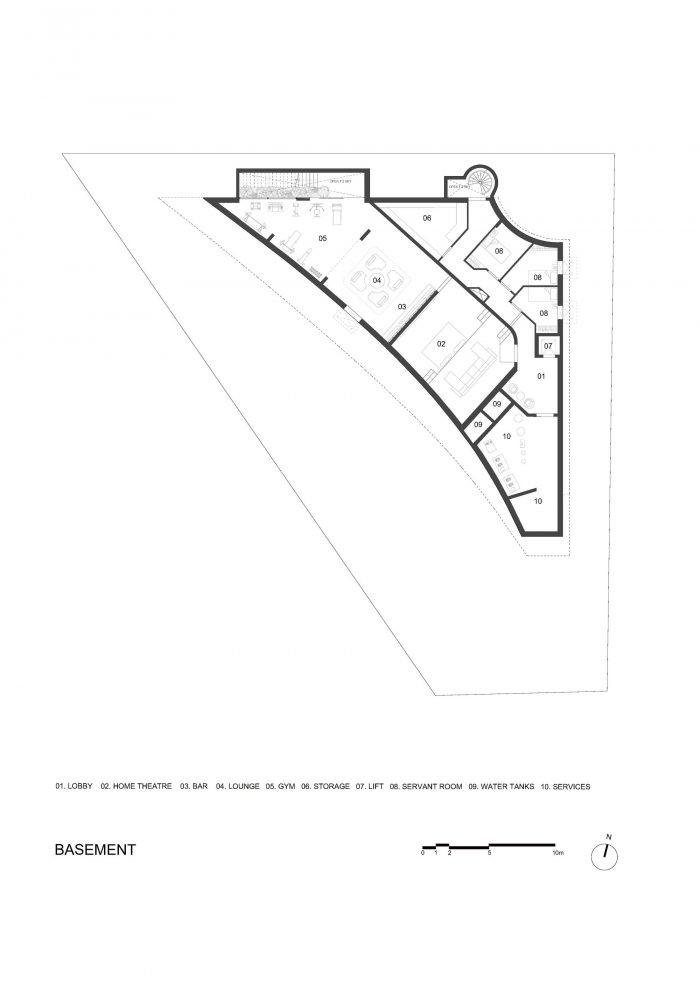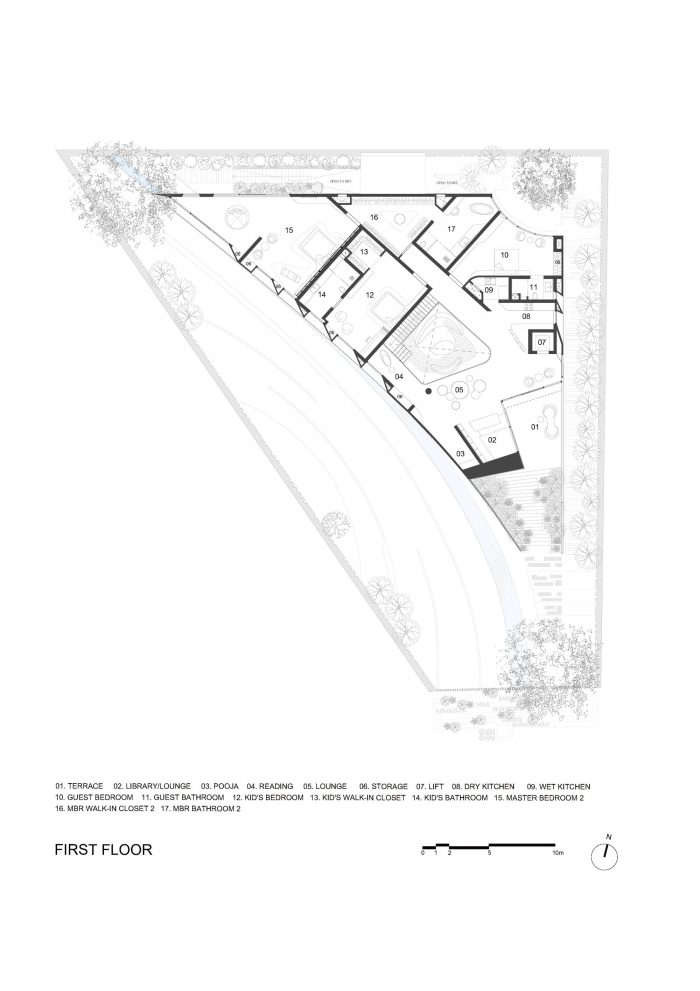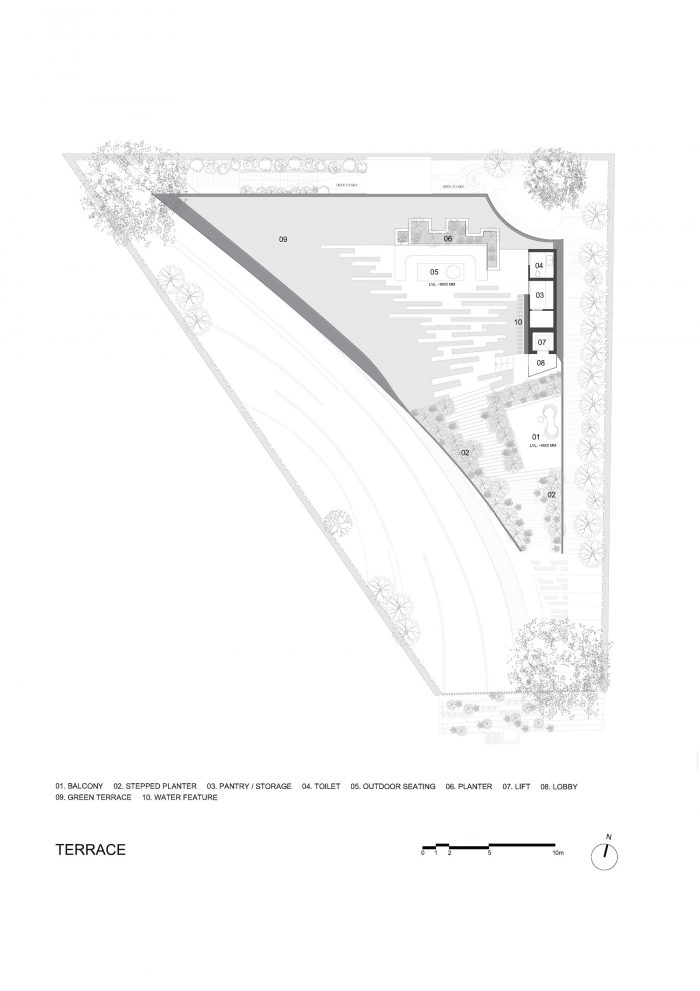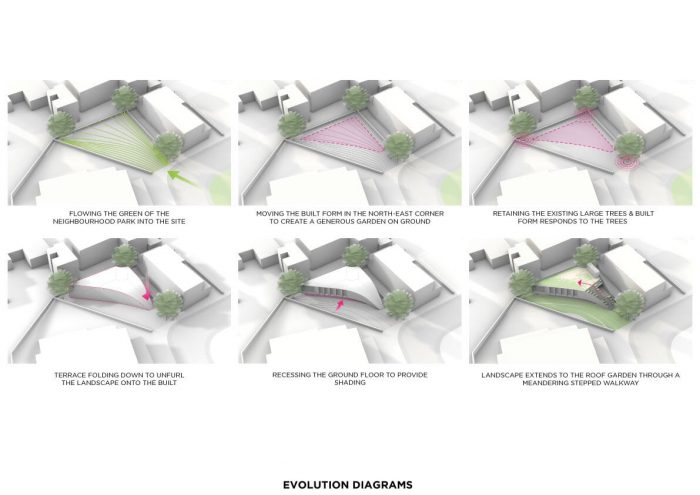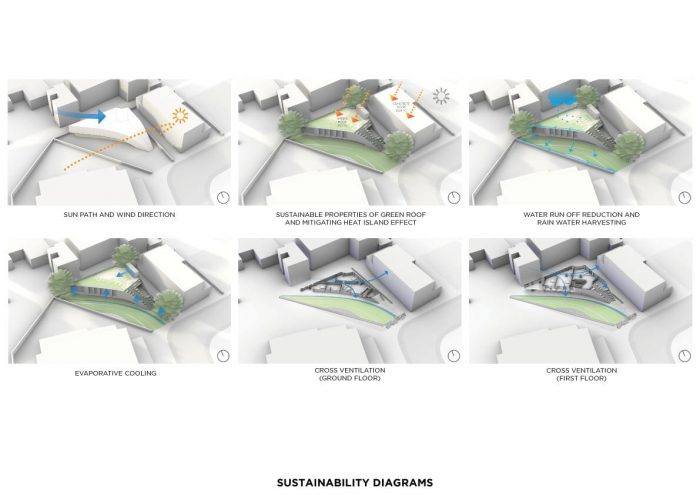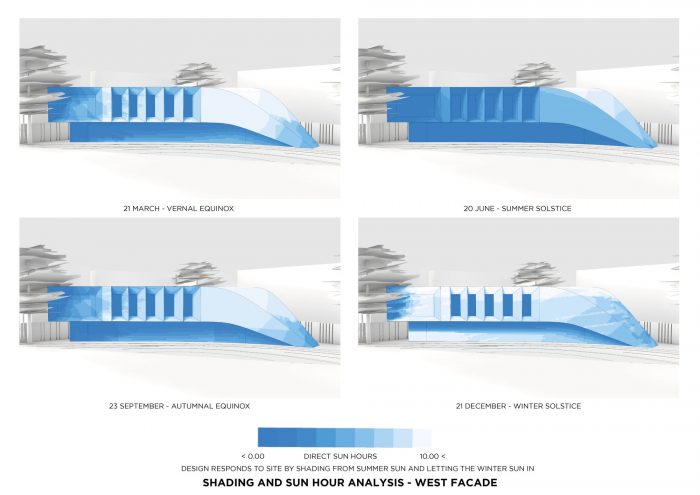设计简介 – 客户的设计简介是创建一个具有最大绿色空间和公园景观的别墅。空间要求是为一个联合家庭创造一个别墅。客户的弟弟和他的妻子以及祖父母住在一楼,他和他的妻子以及儿子住在一楼。家庭影院、酒吧和健身房在地下室,与一个漂亮的室外楼梯和一个天井相连,以引入光线。该地块三面被别墅包围,在最短的第四面提供了附近公园的景观。旁边有三棵突出的树,一棵在入口处,两棵在地块的后侧。客户的设计要求是尽可能地保留这些树木。
Design Brief – Clients design brief was to create a villa with maximum green space and views of the park. The space requirement is to create a villa for one joint family. The client’s brother with his wife and grandparents are on the ground floor and he, his wife, and son are on the first floor. Home theatre, bar, and gym in the basement connected with a nice outdoor staircase and a patio to bring in light. The site is surrounded by villas on 3 sides, offering views of the neighborhood park on the shortest 4th side. Alongside there are three prominent trees on the site, one at the entrance, and two flanking the rear side of the plot. The design brief from the client was to try and retain these trees as much as possible.
作为一个联合家庭,客户希望在房子里有双重互动。首先,需要为他的父母、他兄弟的家人和他的家人提供隐私区,其次,需要为居住在房子里的所有成员提供少数空间。
Being a joint family the client wanted dual interaction in the house. Firstly, zones of privacy were required for his parents, his brother’s family, and his family, and secondly few spaces where all members living in the house can be together.
设计方案–自然中的城市生活–在城市环境中,用户和自然之间的联系越来越紧密。通过这个项目,我们希望创造绿色的城市生活,重新点燃居民与他们周围的自然的关系。这个别墅从景观中脱颖而出,其中心主题是在现场创造最大的绿色覆盖,并利用面向场地的公园的景观。该地块的奇特形状和附近公园的景观被用作设计的驱动力。在主题上,设计着眼于将邻里公园的绿色流向场地,流线从面向南侧的公园出现,并向场地的北部边缘开放。这个基础网格被用来定义建筑形式和景观区域,如水体、硬景观和软景观。
Design Solution – Urban living in the lap of nature – In an urban setting, there is a growing disconnect between the user and nature. With this project we are looking at creating green urban living, to rekindle the relationship of the residents with nature in their immediate surroundings. This villa emerges from the landscape, with the central theme of creating maximum green cover on-site and utilizing the views of the park facing the site. The odd shape of the plot along with the views of the neighborhood park was used as design drivers. Thematically the design looks at flowing the green of the neighborhood park in the site, with streamlines emerging from the park facing the southern side and opening up towards the northern edge of the site. This base grid has been used to define the built-form and landscape zones such as water bodies, hardscape, and soft scape.
建筑形式被战略性地放置在场地的一个边缘,从而在地块的西侧形成了一个宽敞的景观花园,该花园通向双层高的家庭起居室和餐厅,从而延伸到一个户外客厅。建筑形式从景观中出现,并将底层与建筑的屋顶融合在一起,为别墅创造了一个户外连接的脊柱。这条蜿蜒的阶梯式走道在一楼有户外空间,有户外遮阳座椅,并进一步连接到露台。这个在一楼创造的户外露台空间作为一个阳台,同时也是一楼公寓的直接入口。露台上的景观花园可以欣赏到附近公园的景色,有一种与大自然相依相偎的感觉。这三个户外空间根据一天中的不同时间和一年中的不同季节有不同的实用性。
The built form is strategically placed on one edge of the site, resulting in a generous landscaped garden on the west side of the plot which opens up to the double-height family living & dining, thereby extending into an outdoor living room. The built form emerges from the landscape and blends the ground floor to the roof of the building, creating an outdoor connective spine for the villa. This meandering stepped walkway has outdoor space on the first floor with outdoor shaded seating and connects further to the terrace. This outdoor terrace space created on the first floor acts as a balcony and at the same time the direct entrance to the first-floor apartment. The landscape garden on the terrace enjoys the views of the neighborhood park with a feeling of being nested with nature. These three outdoor spaces have different usability based on the time of day and season of the year.
设计中保留了工地上现有的树木,并利用这些树木的遮阳作用创造出环境优美的户外空间,这些空间可以在德里NCR的极端气候条件下使用。设计意图是在立面上创造一种对立,较低的立面是轻盈的,而沉重的体量则漂浮在上面。底层的玻璃立面与室外的绿色空间相连接,而一楼则是用混凝土雕刻出的冲孔窗,以减少热量的吸收,因为这个立面直接暴露在阳光下。
Existing trees on site have been retained in the design and the shading from these trees has been used to create ambient outdoor spaces, which could be used in the extreme climatic conditions of Delhi NCR. The design intent was to create a dichotomy in the façade with the lower façade being light in nature and a heavy volume floating on top of it. The ground floor has a glass façade to connect with outdoor green spaces, and the first floor has punched windows carved out of concrete to minimize heat gain as this façade is directly exposed to the sun.
双层高的客厅、餐厅和开放式厨房空间将两个家庭楼层合并为一个家庭生活区,从而加强了家庭的连通性。可持续的设计策略已经被灌输到设计中,以创造出环境优美的室内和室外空间。底层的西南面和东面的立面都有一个深的悬臂,以削减夏季刺眼的阳光。在底层和露台上设置了水体,以促进蒸发冷却。建筑物的屋顶是由土和草构成的景观平台,这有助于进一步减少别墅的直接热增益。
A double-height living, dining, and open kitchen space combines the two family floors into one zone of family living and thereby strengthening the family connectivity. Sustainable design strategies have been inculcated in the design, to create ambient indoor and outdoor spaces. The ground floor has a deep cantilever on the southwest and east-facing façade on the ground floor to cut the harsh summer sun. Water bodies are provided on the ground floor and terrace to promote evaporative cooling. The roof of the building is a landscaped terrace with earth and grass, this helps further to cut down the direct heat gain of the villa.
可持续性–考虑到德里-北卡罗来纳州的炎热气候条件,本项目的设计是为了让人在室内和室外都感到舒适。底层的浅水体被放置在风向的路径上,有助于蒸发冷却。地面上面向西南的主立面是凹陷的,以阻挡白天的直接阳光,同时保持与外部的无缝视觉连接。傍晚时分,一些阳光使室内充满生机。建筑的上层是由混凝土制成的,窗户向后凹陷,以切断南面的阳光。
Sustainability – Given the hot climatic conditions of Delhi-NCR, this project has been designed for human comfort both indoors and outdoors. A shallow water body on the ground floor has been placed in the path of the wind direction, helping in evaporative cooling. The main southwest-facing facade on the ground is recessed to block the direct sunlight during the day while maintaining a seamless visual connection to the outside. In the early evening, some rays of sunlight animate the interior. The upper floor of the building is made of concrete with windows recessed back to cut the south sun.
现场现有的三棵树被保留下来,在景观中形成阴影区,也有助于减少别墅的阳光照射。露台上的绿色覆盖以及蜿蜒的台阶,确保减少直接的热量摄入。风向被考虑到了房子的交叉通风。
The three existing trees on site have been retained, creating zones of shadow in the landscape and also helping in reducing the sun exposure of the villa. The green cover on the terrace as well as the meandering steps, ensure a reduction of direct heat gain. Wind direction was taken into account for cross ventilation in the house.
Architects: Studio Symbiosis
Area : 1100 m²
Year : 2022
Photographs :Niveditaa Gupta
Manufacturers : Century Plywood, Jaquar, Kohler, AGV Alufab, Asian Paints, Ekka Furniture, FLOS, Greenlam, Mitsubishi, NITCO TILES, P – Security, Schneider
Structure : ACECON
MEP : dbHMS
Lighting : The Luminars
Civil Contractor : Saakar Projects
Landscape Design : Studio Symbiosis Architects
Interior Design : Studio Symbiosis Architects
HVAC : dbHMS
Interior Contractor : NICHE Architects
Associate And Design Development : Kartik Misra
Associate And Coordination And Supervision : Nitish Talmale
Project Architects : Govinda Dey
Site Coordination And Client And Consultant Coordination : Govinda Dey
Vendor Coordination And Site Management : Govinda Dey
Architect And Design And Drawings : Krishan Sharma
Architect And Drawings And Visualization : Anjan Mondal, Arun Marigoudra
Façade Design : Studio Symbiosis Architects
City : Ghaziabad
Country : India



